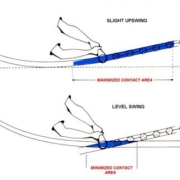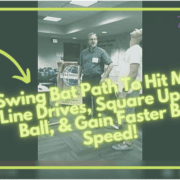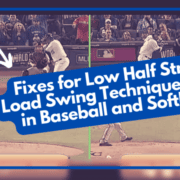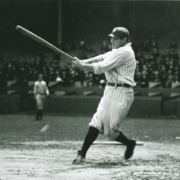Can Metal Baseball Bat STOP Wrist Rolling Over In Swing Path? Easton’s Mako Torq Composite CANNOT
Discover whether a metal baseball or softball bat (aluminum, composite, etc) can STOP wrist rolling over in the swing path? Learn how the Easton’s Mako Torq bat CANNOT! Why? Because “rolling over” is a timing issue, NOT a mechanical breakdown. Good timing equals NO wrist roll. Therefore, this bat was as irrelevant as the Easton “engineer” that bad mouthed me when I first published this post.
Composite Bats: Easton Mako Torq MISSED The Mark?
As a side note, let me clear the air about metal vs aluminum vs composite because there seems to be quite the confusion in the YouTube comments. In doing a quick Google search:
- Is aluminum a type of metal? “Aluminum is the most abundant metal on Earth, and one of the cheapest to buy. Aluminum is the third most common element in the Earth’s crust, but it also bonds easily with other elements. That means it is not found in nature as a pure metal.”
- Are alloys considered metal? “An alloy is technically an impure metal, but when referring to alloys, the term impurities usually denotes undesirable elements. Such impurities are introduced from the base metals and alloying elements, but are removed during processing.”
- Are composite bats metal? “Composite baseball bats, opposed to aluminum or wood baseball bats, incorporate a reinforced carbon fiber polymer, or composite, into the bat’s construction. This composite material can make up all or part of the bat. Bats made entirely of this polymer are referred to as composite bats.”
Okay, on with the review…
Let me be clear about the objective of this article. There are bats, and there are hitting aids. Easton Mako Torq composite bats have attempted to fuse both together. This is fine, but the price point is high ($280-550) when compared to a simplified alternative.
We HAVE to scrutinize hitting aids with science, like we do efficient hitting movements. If you haven’t heard of Easton Mako Torq composite bats yet, then here you go…
Key product marketing differentiation says they use “360-degree Torq Rotating Handle Technology”. Easton’s claim is to stop a hitter from rolling their hands over at contact. Their launch video says these composite bats help to be “short to the ball”, “square up more pitches”, “get to the zone faster”, and “stay in the zone longer”.
Let’s answer these THREE questions:
- Is rolling over a big problem?
- What do cues like being “short to the ball” really mean? And,
- Attack of the shady Easton “engineer”?
SCIENCE-BASED TRAINING:
Improve your hitting strategy dramatically by applying human movement principles.
Learn not only how and what to train but also the science behind the methods.
Is Rolling Over a Big Problem?
Short answer is YES. The real question is, is rolling over a mechanical problem? NO. It’s a timing problem. I would challenge you to find a hitter ON-TIME rolling over. Even with the worst thing you can think of, try and find THAT swing rolling over.
With that being said, making a bat that “cures” rolling over is COMPLETELY irrelevant. And if that’s your main marketing point, then you’re conning people into buying your gimmick.
What Do Cues like Being “Short to the Ball” Really Mean?
The marketing for Easton Mako Torq composite bats promise – that by using their bat – a hitter will:
- “Be short to the ball”,
- “Square up more pitches”,
- “Get to the zone faster”, and
- “Stay in the zone longer”.
Let’s briefly break these claims down…
“Be short to the ball”
Being short to the ball is a term we use for middle in and middle up pitches. This is achieved with top hand barrel control. It can be argued that a more balanced bat would make it easier to control the barrel, rather than an end loaded one, but that has zero correlation to the Easton Mako Torq technology.
“Square up more pitches”
If rolling handle technology can counteract a hitter from rolling their wrist over at contact, then this may be true, sometimes. Squaring up more pitches has MORE to do with a hitter’s timing. Also, where a hitter makes contact in the impact zone can be the difference between hitting the sweet spot consistently or not. Unfortunately, the Easton Maco Torq DOES NOT help with timing or a hitter’s contact point.
“Get to the zone faster”
Getting to the zone (impact zone I assume) is all about the Conservation of Angular Momentum. Since a hitter doesn’t know which type of pitch, speed, and location beforehand, it’s a race – after a decision to swing has been made – to get the barrel on the pitch plane as soon as possible. In order to spin faster, the hitter MUST stay tight in the turn until the barrel is on plane.
“Stay in the Zone longer”
Here’s where I think Easton Mako Torq composite bats hit the mark. IF – and it is a BIG “if” – these bats can stop rolling over, then a hitter’s “stay through” will get better. But at a price ($280-550). And once the hitter has to swing a normal “one-piece” bat, then I’m not sure if the anti-roll over mechanics would transfer. I don’t see higher levels adopting Easton Mako Torq composite bats.
Attack of the Shady Easton “Engineer”?
Post UPDATE: By the way, about a couple months after publishing this YouTube and article (when it began to gain serious traction – and as of this ‘update’ the video has been viewed almost 90K times on YouTube), one of Easton’s engineers contacted me VERY unprofessionally. Clearly he had a bone to pick. Saying I had zero ground to stand on, and how could I ‘bad mouth’ their precious Mako Torq technology…that I didn’t know what I was talking about. What’s laughable is that this “engineer” couldn’t supply me with credible studies that supported their claims…he said they had them, but he wouldn’t share. Hmmmm…
Let me be clear, I LOVE Easton bats, and preferred them well over Louisville Slugger’s. However, I don’t agree with their opinion on Torq technology benefits.
From what I’ve heard, Easton purchased the patent from a High School player who made the technology, in wood shop class, to alleviate pain in his wrist when swinging. IT WORKED!! If Easton would have marketed it based on that, there would be no discussion. But I feel they stretched the technology truth a bit too much. You be the judge.
- Fix Late Swings Fast: 2025 Pitch Recognition & See-Decide-Swing Training for Youth Baseball Power Hitters - October 6, 2025
- Safe Youth Weighted Bat Training: Proven Overload/Underload Drills to Increase Exit Velocity in Games Starting Tonight - September 29, 2025
- AI Coaching Course 2025: Youth Baseball & Softball Practice Plan + Off-Season & In-Season Workout Builder Fast - September 23, 2025













From what I gathered, this is just another tin bat. As far as I’m concerned, as soon as a kid is serious about baseball, and as soon as they can use a barrel larger than 2 1/4 inches, they should dump the compo and tin a switch to wood. So this is all academic. Who cares about this bat, it’s a toy – and they should sell them at TOYS R US, or Wal Mart. College baseball still uses them, as they say … because wood bats are more expensive in the long run because they break. That’s BS as far as I’m concerned. There are many alternatives to using play-toy bats, such as McDougalls, Bamboo, or those bats that have compo handles but wood barrels. I think College baseball uses them because they are getting some endorsement money, weather they want to disclose that or not. It’s the only reason I can think of – there are just too many alternatives that come closer to all wood that they could use. Check out the Mine bat site – and there are dozens of others. They may also want to boost enrollment because they want players to go there for 4 years, and draw all the fans etc., because there is huge money in it. Like college basketball and football, with their billion dollar T.V. contracts. College baseball is not as big, but the last thing they want is to have some kid who they can market as a big time, blue chip prospect come in and only hit 310 feet to dead center on a good day. They want to see those bombs to put people in the seats.
So just forget this piece of junk, get your hands on a good wood bat and play some real baseball.
I totally agree with you Bob. If you think about it, college and even High School baseball isn’t where all the money is in aluminum bats. It’s in Youth baseball and softball. They have the bigger pools of players (and paying parents) to choose from. I think these levels are the ones getting exploited. At the end of the 2008 youth baseball season, there were 2.6 million Little Leaguers worldwide. And 400,000 youth softball players. This was according to LittleLeague.org stats. At Fresno State, we all got “free” bats. Not sure if our program paid for them or not, but we were definitely sponsored by Easton or Louisville. I think it’s a publicity play for these companies. Just like in fashion. Get celebrities wearing your clothes in the open where the masses can see. The money isn’t in the celebrities, it’s in the masses.
Easton supplies the LLWS as well don’t they? Without getting too political in this forum, they make a ton of money off that event, and there are parents who basically shell out their life savings to have their kid play ball in that tournament. Major Jr. hockey in Canada is under the gun now because most of those players are working age, and they get little compensation for basically playing in a pro league. With the revenues from the gate, parking, food sales, souvenirs, T.V., etc. and the World Jr. Championship at Xmas, Major Hockey is walking away with wheel barrels full of money … and the players want some.
There is a movement afoot to form a players union to negotiate paying the players.
Many, if not most, of those franchises are now owned by former NHL players, and there are big dollars involved. There’s no crime against making a buck, but … if that’s the argument for the owners side, then it certainly can be used by the other side too. If the people that make the kind of money we know gets generated by sports that are developmental leagues for the pros (in all sports), and have a clear conscience doing it, then it should be open season on anyone who can prove they have a legal, if not moral right to their share. That goes for University Sports too.
These kids spend years and and lots of money to play a sport. Some do it because they love it and want to make it their life’s work, some because they want scholarships, etc. I asked my son this question … “What if you had the choice of working in a gas station for 12 bucks and hour, or playing in the MLB for 12 bucks an hour … which would you take?” Guess which one he picked?
Back to the bat … if you want a faster, cleaner, shorter, or whatever other words they want to use to describe the swing you’ll have if you get their bat, just forget it and do what Joey says to do.
I agree Bob, working on clean efficient mechanics doesn’t cost a thing. Didn’t know that about hockey, but I’m not surprised. Thanks for sharing (as usual 😉 that information.
Each kid on each team in the llws tournament gets the latest generation bats from Easton for free… they even have the choice of swinging it or not.
It is not conservation of angular momentum that you’re talking about, just angular momentum. Your link to the conservation page is dead anyhow.
Many of these aids are necessary because little league coaches teach kids to use heavy bats. Then they develop bad habits like long swings and rolling over. If heavy bats were better, they wouldn’t make rules about minimum weights and maximum drops.
Michael, saying I’m actually talking about “Angular Momentum” versus the “Conservation of Angular Momentum” is like calling “Bob”, “Robert”. It’s the same thing. I’m talking about conserving Linear into Angular Momentum. I fixed the link by the way, which will shed light on what I’m talking about.